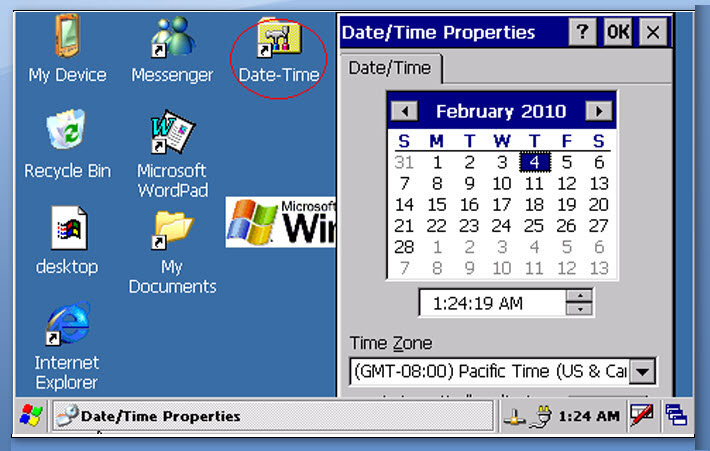A recently invoked query on the MSDN news group for Windows CE has induced me to script this post. Most WinCE professionals might be aware of creating short-cut for a file. Now the question is – Would it be possible to create a short-cut to every individual control panel application? The answer is a definite YES!
Shortcut syntax
A shortcut file has the extension of .lnk, containing the following entry as a command line parameter.
nn# command [optional parameters]
Where “nn” denotes the number of characters followed by the # symbol. The “command” denotes the actual command and the “[optional parameters]” represent the optional arguments for the command. For example, 27#\Windows\iexplore.exe –home – is a command to open internet explorer with home page. This entry should also be saved in the iexplore.lnk file.
Control Panel Applets
Control panel applets are individual configuration tools, implemented in the form of .cpl files listed with icon and name in the Control Panel user interface. A .cpl file is a DLL that implements the CPlApplet API. Ctlpnl.exe loads and runs the control panel applets. A single .cpl file can contain single as well as multiple Control Panel applications.
Shortcut to Control Panel Applets
Normally we can create short-cut for a single file or a .cpl file containing single control panel application in a straight forward approach. An example for this is as follows:
33#”ctlpnl.exe” \Windows\intlp.cpl
Where Intlp.cpl is a control panel applet for regional language settings that contains a single control panel application.
Another example for a control panel applet containing multiple control panel application is cplmain.cpl.
Following is the list of short-cut entries for each control panel application that resides in the Cplmain.cpl.
- PC Connection – 35#”ctlpnl.exe” \Windows\cplmain.cpl,0
- Dialing – 35#”ctlpnl.exe” \Windows\cplmain.cpl,1
- Keyboard – 35#”ctlpnl.exe” \Windows\cplmain.cpl,2
- Password – 35#”ctlpnl.exe” \Windows\cplmain.cpl,3
- Owner – 35#”ctlpnl.exe” \Windows\cplmain.cpl,4
- Power – 35#”ctlpnl.exe” \Windows\cplmain.cpl,5
- System – 35#”ctlpnl.exe” \Windows\cplmain.cpl,6
- Display – 35#”ctlpnl.exe” \Windows\cplmain.cpl,7
- Mouse – 35#”ctlpnl.exe” \Windows\cplmain.cpl,8
- Stylus – 35#”ctlpnl.exe” \Windows\cplmain.cpl,9
- Volume & sounds – 35#”ctlpnl.exe” \Windows\cplmain.cpl,10
- Input Panel – 35#”ctlpnl.exe” \Windows\cplmain.cpl,11
- Remove Programs – 35#”ctlpnl.exe” \Windows\cplmain.cpl,12
- Date/Time – 35#”ctlpnl.exe” \Windows\cplmain.cpl,13
- Certificates – 35#”ctlpnl.exe” \Windows\cplmain.cpl,14
- Accessibility – 35#”ctlpnl.exe” \Windows\cplmain.cpl,15
Ctlpnl.exe invokes the cplmain.cpl with its parameters 0 to 15 to execute the corresponding control panel applications. The parameter to the cplmain.cpl is given from 0 to 15 based on the array index value of CPLAPPLETINFO rgApplets[] = { …….}. This control panel applet table presents in the \PUBLIC\ WCESHELLFE\OAK\CTLPNL\CPLMAIN\cpltable.cpp file.
Exposing Shortcut on Desktop
Following steps are involved to integrate the short-cut file with the OS image:
- To create the required short-cut, copy the short-cut command line parameter entry in notepad application and save it as a .lnk file. For example, short-cut file for Date-Time.lnk will contain the following entry.
35#”ctlpnl.exe” \Windows\cplmain.cpl,13
- Copy this file to your \WINCE600\PLATFORM\<your BSP>\Files folder. This will then be automatically copied to your release folder during build process.
- Open a \WINCE600\PLATFORM\<your BSP>\Files\platform.bib and add the following entry in the FILES section to make this short-cut file as a part of the nk.bin.
Date-Time.lnk $(_FLATRELEASEDIR)\ Date-Time.lnk NK
This Date-Time.lnk will be resided in \windows folder of your device.
- Open the \WINCE600\PLATFORM\<your BSP>\Files\platform.dat and add the following entry to show the short-cut on desktop.
Directory(“\Windows\LOC_DESKTOP_DIR”):-File(“Date-Time.lnk”,”\Windows\Date-Time.lnk”)
- The following figure shows the short-cut for Date-Time control panel application on the device desktop and also has been indicated by a red elliptical mark.

